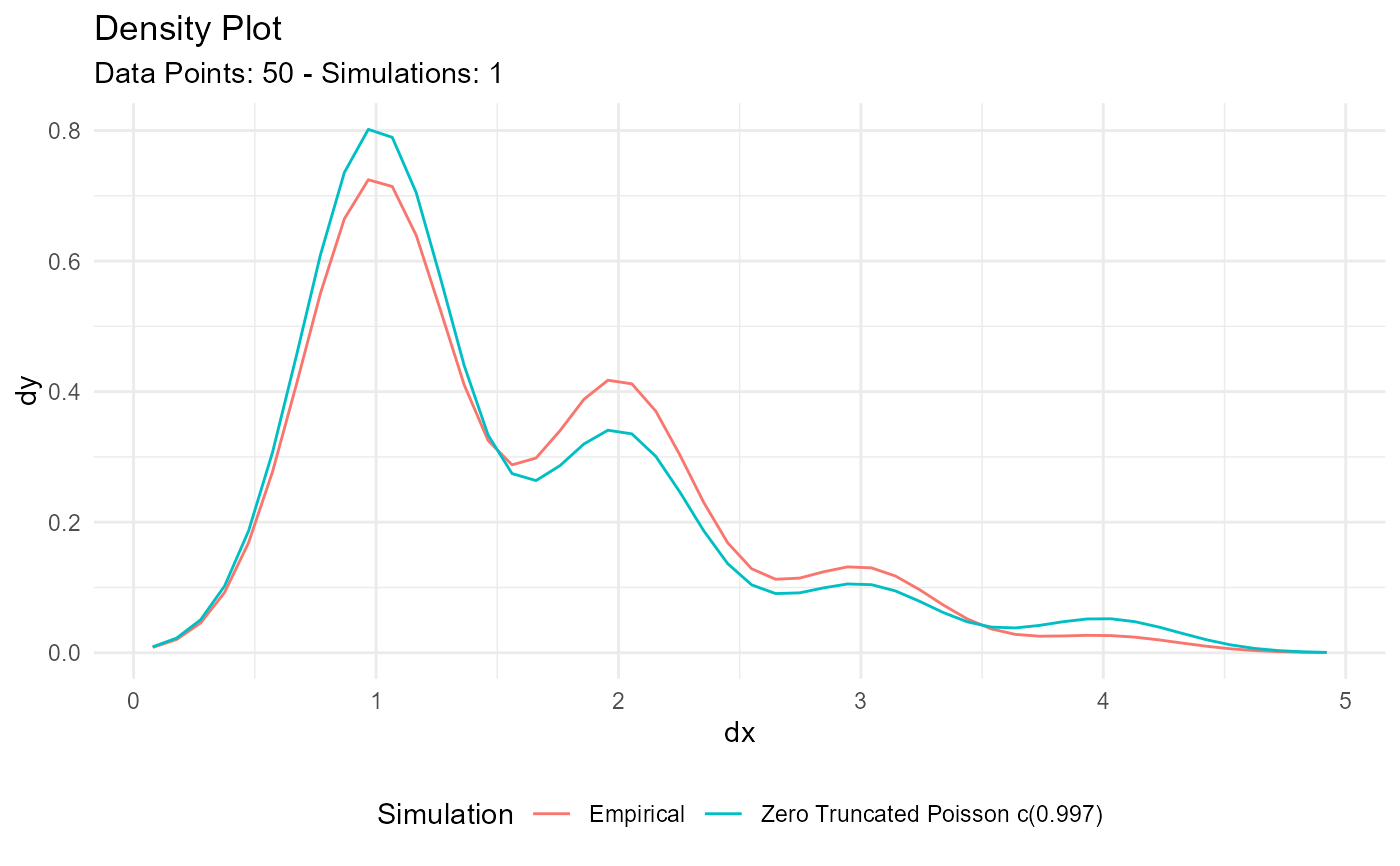
Estimate Zero Truncated Poisson Parameters
Source:R/est-param-ztpois.R
util_zero_truncated_poisson_param_estimate.RdThis function will attempt to estimate the Zero Truncated Poisson
lambda parameter given some vector of values .x. The function will return a
tibble output, and if the parameter .auto_gen_empirical is set to TRUE
then the empirical data given to the parameter .x will be run through the
tidy_empirical() function and combined with the estimated Zero Truncated
Poisson data.
Arguments
- .x
The vector of data to be passed to the function. Must be non-negative integers.
- .auto_gen_empirical
This is a boolean value of TRUE/FALSE with default set to TRUE. This will automatically create the
tidy_empirical()output for the.xparameter and use thetidy_combine_distributions(). The user can then plot out the data using$combined_data_tblfrom the function output.
Details
This function estimates the parameter lambda of a Zero-Truncated Poisson distribution
based on a vector of non-negative integer values .x. The Zero-Truncated Poisson
distribution is a discrete probability distribution that models the number of events
occurring in a fixed interval of time, given that at least one event has occurred.
The estimation is performed by minimizing the negative log-likelihood of the observed
data .x under the Zero-Truncated Poisson model. The negative log-likelihood function
used for optimization is defined as:
$$-\sum_{i=1}^{n} \log(P(X_i = x_i \mid X_i > 0, \lambda))$$
where \( X_i \) are the observed values in .x and lambda is the parameter
of the Zero-Truncated Poisson distribution.
The optimization process uses the optim function to find the value of lambda
that minimizes this negative log-likelihood. The chosen optimization method is Brent's
method (method = "Brent") within a specified interval [0, max(.x)].
If .auto_gen_empirical is set to TRUE, the function will generate empirical data
statistics using tidy_empirical() for the input data .x and then combine this
empirical data with the estimated Zero-Truncated Poisson distribution using
tidy_combine_distributions(). This combined data can be accessed via the
$combined_data_tbl element of the function output.
The function returns a tibble containing the estimated parameter lambda along
with other summary statistics of the input data (sample size, minimum, maximum).
See also
Other Parameter Estimation:
util_bernoulli_param_estimate(),
util_beta_param_estimate(),
util_binomial_param_estimate(),
util_burr_param_estimate(),
util_cauchy_param_estimate(),
util_chisquare_param_estimate(),
util_exponential_param_estimate(),
util_f_param_estimate(),
util_gamma_param_estimate(),
util_generalized_beta_param_estimate(),
util_generalized_pareto_param_estimate(),
util_geometric_param_estimate(),
util_hypergeometric_param_estimate(),
util_inverse_burr_param_estimate(),
util_inverse_pareto_param_estimate(),
util_inverse_weibull_param_estimate(),
util_logistic_param_estimate(),
util_lognormal_param_estimate(),
util_negative_binomial_param_estimate(),
util_normal_param_estimate(),
util_paralogistic_param_estimate(),
util_pareto1_param_estimate(),
util_pareto_param_estimate(),
util_poisson_param_estimate(),
util_t_param_estimate(),
util_triangular_param_estimate(),
util_uniform_param_estimate(),
util_weibull_param_estimate(),
util_zero_truncated_binomial_param_estimate(),
util_zero_truncated_geometric_param_estimate(),
util_zero_truncated_negative_binomial_param_estimate()
Other Poisson:
tidy_poisson(),
tidy_zero_truncated_poisson(),
util_poisson_param_estimate(),
util_poisson_stats_tbl(),
util_zero_truncated_poisson_stats_tbl()
Examples
library(dplyr)
library(ggplot2)
tc <- tidy_zero_truncated_poisson() |> pull(y)
output <- util_zero_truncated_poisson_param_estimate(tc)
output$parameter_tbl
#> # A tibble: 1 × 5
#> dist_type samp_size min max lambda
#> <chr> <int> <dbl> <dbl> <dbl>
#> 1 Zero Truncated Poisson 50 1 4 1.03
output$combined_data_tbl |>
tidy_combined_autoplot()
